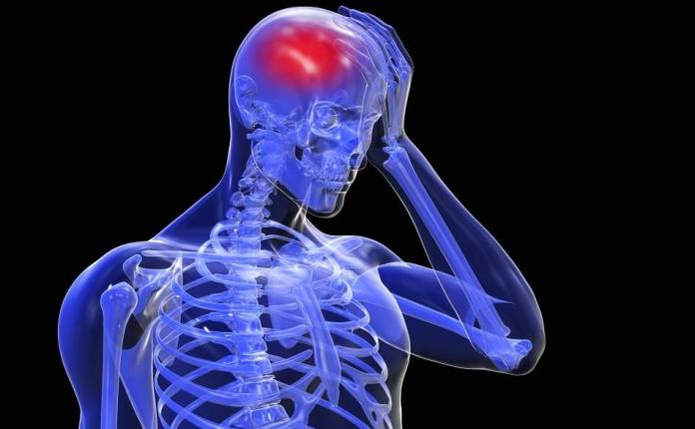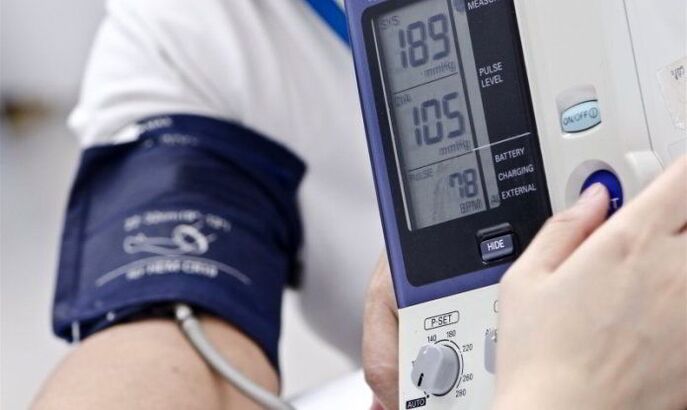Cervical osteochondria is a spine disease, characterized by disorders of intervertebral discs.The pathology is characteristic of the elderly, but a person of any age can meet her.Tangible discomfort causes one of the main signs of this disease - severe pain.The patient should know what is dangerous and what problems they should face.
The details of the disease
The cervical area of the uterus is one of the most mobile parts of the body and meets regular loads.With the development of osteochondry, the shift of the vertebrae, which leads to the compression of numerous ships and nerves.The main complexity of the pathology is that characteristic dystrophic changes affect spinal nerve roots and intervertebral discs.Because of this, the brain remains without the necessary oxygen, blood supply is lost.

In the danger zone, there are mainly elderly people in which the disease develops in the context of metabolic disorders and changes in the structure of the vertebrae and intervertebral discs are related to age.The reason for the development of such violations can also be:
- deposition of salt;
- insufficient physical activity;
- Inappropriate nutrition.
- injuries;
- Frequent hypothermia.
- Hormone problems;
- Overweight.
- Chronic diseases.
The osteochondria also causes a long -standing presence of the body in a position that puts office employees and drivers under the hit.
Osteochondal symptoms
At the initial stage of the disease, the symptoms are almost invisible, stress can only cause mild pain in the throat.But as the pathology develops, the symptoms are gradually increasing.
The cervical spine osteochondria can be identified by the following signs:
- Severe pain in the throat, neck, shoulders.
- tactical migraines;
- weakness of the hands;
- Neck mobility is limited.
- When you turn your head, the vertebrae are broken.
- Hearing problems;
- A characteristic ringing appears in the ears.
- Throat discomfort.
In the early stages, the pain syndrome occurs only during movement, when it leans or turns the throat.Over time, the pain occurs even when the position of the hands changes.
Possible complications
If cervical osteochondria is not treated, degenerative processes in the intervertebral discs will lead to the loss of their main functions and a decrease in density.Excessive spine mobility will gradually grow, muscles, joints and joints will suffer.The pressure on the nerve endings and the spinal cord will only intensify, which will lead to increased symptoms and the development of new pathological phenomena.

Frequent migraines
In the most common consequences of cervical spine osteochondicity, you can calculate a headache.This is because it is at this site that the spine is located, which is responsible for providing oxygen and blood to the brain.
As the disk power changes, depreciation is violated.Damaged vertebrae presses on the artery, interfere with blood circulation and "delivery" of the necessary oxygen.Muscle cramps grow.
Following the pain, the consequent symptoms often follow:
- nausea;
- throw up;
- sharp increase in pressure.
- tingling in shoulders.
- Weakness throughout the body.
With serious attacks, it is desirable to relax as much as possible, it is better in a horizontal position.An unpleasant syndrome can remove painkillers or cold compressions, while massage is useless.
Vision problems
Complications of cervical osteochondrication often affect the organs of vision: in this part of the spine there are drowsiness and spine, which are responsible for blood flow to the visual central structure.Compression of nerve roots and blood vessels leads to hypoxia and causes a decrease in vision.
Together with spine syndrome, symptoms such as:
- fog;
- darkening in the eyes.
- the appearance of "flies" or colored signs.
- branch;
- Excessive stress of the optic nerve.
- dizziness;
- nausea.

During the examination, a specialist may observe a stenosis of the arterial vascular vascular vascular vascular vascular vascular vascular vascular vascular vascular vascular vascular vascular vascular vascular.Also, in the context of the disease, glaucoma can occur, accompanied by increased intraocular pressure and pain.
Hearing problems
Due to the compression of the spinal artery and nerve roots, hearing loss is possible by 20-30%.The neglected osteochondria can lead to complete deafness.To avoid this, you must contact a doctor in the first symptoms of the disease.
A slight decrease in hearing is reversible: in addition to the treatment of a doctor provided by a doctor, the patient needs special exercises or ears massage.Watching the TV or music listening is better in a small volume to stretch the hearing organs.
Hypotension or hypertension
Reduced or increased blood pressure are quite common consequences of cervical osteochondicity.The greatest risk is hypertension, which are characteristic:
- The spawning of the pulse.
- Increased sensitivity to temperatures.
- Sleep disorders.
- nasal bleeding.
- Dyspnoea?
- heart pain
- Sweating.
The higher the blood pressure, the greater the load falls to the heart that leads to its rapid wear.As a result, heart failure develops.In hypertension, atherosclerosis develops faster, which is dangerous with a stroke.
Hypotenia is not an immediate threat to life, but it greatly affects its quality.The body experiences oxygen starvation, which affects the patient's general well -being.The hypotension is characterized by violations of venous and arterial blood supply and this results in disorders in the sensitivity of the limbs.Among the possible complications is myocardial infarction.

Vegetables -Vascular Dystonia
Vegetables -angiogenic dystonia is a general name of the syndrome, which can affect various systems and organs of the body.Most of the pathology, cardiovascular system and peripheral nerves suffer from pathology.The patient has constant stress and sharp emotional differences.Frequent panic attacks are also possible and heart rate becomes more common.
Symptoms of dystonia can be lubricated or disguised as other diseases.The consequences of cervical osteochondicity in this case are also not the most enjoyable.Thus, the gastrointestinal tract often suffers: nausea and vomiting, diarrhea, constipation and severe abdominal pain are possible.Gall bladder or liver disorders are possible.Patients often complain about tachycardia, pressure problems and heart pain.
Intervertebral hernias
With an intervertebral hernia, the fragments of the disc "protrude" to the vertebral channel or fall out.The initial stage of this pathology is called protrusion.The integrity of the intervertebral disc is not disturbed by it, but there is a slight protrusion of the bones in the spine.At this stage, the pressure on the spinal cord roots, so the main symptom is the weak pain that occurs during movement.In the later stages, pain syndrome is enhanced.
Vertebral mobility is gradually reduced.Muscle tension is enhanced, even if the patient appears to be in a loose condition.You can also mark periodic weakness in the upper parts of the hands or on the wrists.Hand numbness occurs and often a stinging occurs that often occurs near the thumb.
This is what is a dangerous cervical spine osteochondria with hernia: it has a severe load on the artery, which passes by the spine and is essential for proper blood supply to the brain.If there is excessive pressure from the patient, ischemic vessels may be expected.
A large hernia is dangerous for inflammation of the surrounding joints - this is filled with cervical radical.Only early treatment can prevent complications.The patient should carefully listen to his body and advises a doctor in the first symptoms.Suspicions must cause:
- sharp nausea attacks without visible reasons.
- darkening in the eyes when moving.
- noise in the ears when turning the head.
- Pulling senses in the throat with a long stay in a stand.
The most serious complications are the risk of irreversible paralysis of one or both hands.The atrophy of the brain nerve leads to it, which is located in the cervix area.If the hernia begins to put pressure on the blood vessels, they will gradually die, which will lead to the ninery of many organs.
Vestibule syndrome
Barrel vestibule syndrome is a condition in which the patient is experiencing a strong dizziness that accompanies the loss of orientation.
The attacks arise with a sharp rise, a quick turn or throwing the head back.Characteristic of state:
- noise in the ears.
- nausea;
- visual harm;
- The feeling that everything revolves and floats in front of his eyes.
The main reason for the pathology is the lack of blood supply, which involved the dysfunction of the vestibule.Syndrome will occur more and more often as osteochondria develops.
Glorious
The start of osteochondria is dangerous with neurovascular throat and larynx disorders.Syndrome is characterized by:
- hoarseness;
- difficulties when swallowing.
- stable feeling of coma in the throat.
- dryness and pain.
- Complete voice loss.
The syndrome suddenly occurs and is accompanied by dizziness.
Bar Lieu Syndrome
The second name of the pathology is the spinal artery syndrome.The reason for its development is the stenosis (stenosis) of the spine, in which spinal cord convulsions and blood vessel and nerve compression.
Symptoms include:
- hypertension;
- nausea;
- tachycardia;
- carving in the eyes.
- noise in the ears.
- Loss of coordination of movements;
- pulsating pain in the temples or in the area of the occipital area.
With a sharp movement or throat, the patient may lose consciousness.

Argue syndrome
At the same time, the hypothalamus suffers from the syndrome - a part of the brain responsible for metabolism, pressure, sleep, body temperature and a person's emotional reactions.Functional disorders can be manifested by enhancing or weakening the activity of the section of the brain.In the first case, the patient becomes irritable, in the second - inhibited.
Symptoms often resemble neurasthenia, which manifests through:
- Sleep disorders;
- dissatisfaction;
- Irritable?
- High fatigue.
- Mood volatility.
A person loses the opportunity to concentrate, there are problems with memorization.The irrational outbreaks of anger are possible, the appetite disappears, the libido is reduced.
It is best to avoid any disease than to be treated, predicts the behavior of osteochondry is quite difficult.If there are risk factors, you must regularly perform a set of simple physical exercises that will increase vertebrae mobility and eliminate congestion in the collar area.
The frequent occurrence of any of the described symptoms is the obvious body signal for the problems that occur in it.At the same time, confidence is useless and without consulting a specialist it will not work.


















































